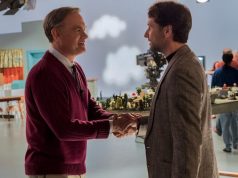“Antichrist” is the only film I’ve ever seen where the credits mention someone whose job was “research on misogyny.” Apparently Lars von Trier takes his hatred of women so seriously that he assigns someone especially to oversee that portion of the film.
But I’m being unfair to von Trier. His misogyny need not be subdivided from his general misanthropy. “Antichrist” has only two characters, a married couple, and the appalling emotional and physical abuse they inflict upon themselves and each other comprises the bulk of the film. Von Trier depicts this so artfully, at times beautifully, that I’m obligated to declare it a “good movie,” i.e., one that has been well made. But does it have any lasting value? Is there any purpose in showing this cruelty in such shockingly graphic detail, other than to get people talking about how shockingly graphic it is? No.
The husband and wife are played by Willem Dafoe and Charlotte Gainsbourg. The characters aren’t given names. Perhaps they represent All Of Us, or perhaps they are awful creatures who don’t deserve individual identities. They are grieving the death of their young son — or, rather, she is grieving. He, a therapist by profession, is cold and detached, his interest in helping his wife work through her grief more clinical than affectionate. “I never interested you until now, when I’m your ‘patient,'” she says, not without some validity.
They retreat to their cabin in the woods, called Eden, because she has expressed some fear of this place and he thinks working through that fear will be therapeutic. He is good at his job (the credits list someone who oversaw the therapy elements of the movie, too), and his treatment methods with his wife seem to be getting results. In the meantime, however, he starts seeing unusual things in the woods, animals caught between life and death, a fox with the power of speech. Sometimes the landscape warps, like a movie projected on a billowing sheet. Von Trier, with acclaimed cinematographer Anthony Dod Mantle (“Slumdog Millionaire”), captures many images of melancholic beauty in these misty woods. In fact, there’s a lot of visual loveliness in the film, interspersed with the unspeakable ugliness.
I mentioned that misogyny plays a role in the film. It isn’t just subtext, though. It’s addressed outright when it’s revealed that the wife has come to believe that women are evil by nature. Then, as if to prove herself correct, she lashes out violently at her husband, who must now defend himself against a woman for whom he doesn’t seem to have ever cared much anyway. After a lot of gradual, slow-moving weirdness, von Trier finally gets down to the business of horrifying us. And he succeeds, too, using all manner of distasteful violence, much of it sexual in nature, to produce a feeling of … what? What are we supposed to feel here? Repulsion? Ickiness? Well, yeah. Nice job. Hooray for you, Lars.
So what is “Antichrist”? It is arthouse psychological horror, with a dash of sadism and pornography thrown in for good measure. Some of it is “supernatural,” though I hesitate to use that word because it implies it might be fun. There is no payoff, at least not in the traditional sense. My understanding of and appreciation for von Trier’s intentions might be deepened with a second viewing of the film, but I’m not prepared to make that kind of sacrifice. Imagine a “Saw” film with a slower pace and more pretentious ambitions and you’ve got “Antichrist.”
C+ (1 hr., 48 min.; )





